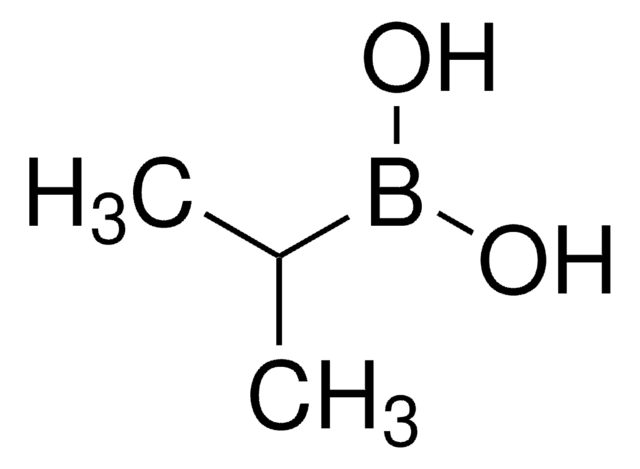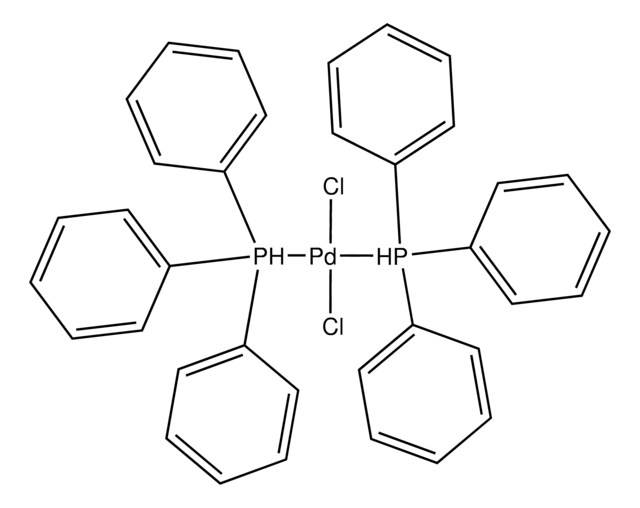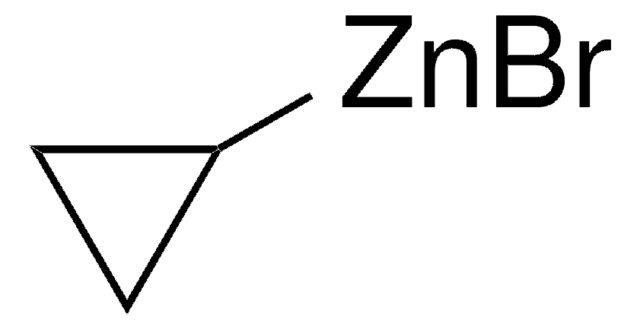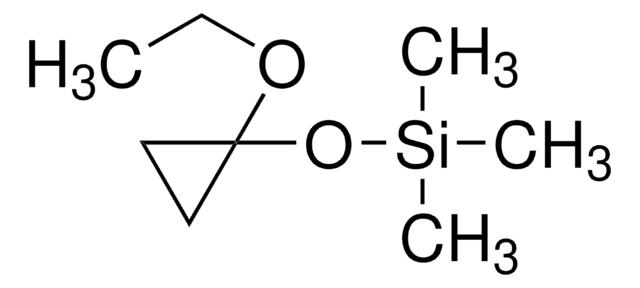Products may be shipped at a different temperature than the recommended long-term storage temperature. If the product quality is sensitive to short-term exposure to conditions other than the recommended long-term storage, it will be shipped on wet or dry-ice. If the product quality is NOT affected by short-term exposure to conditions other than the recommended long-term storage, it will be shipped at ambient temperature. As shipping routes are configured for minimum transit times, shipping at ambient temperature helps control shipping costs for our customers. For more information, please refer to the Storage and Transport Conditions document: https://www.sigmaaldrich.com/deepweb/assets/sigmaaldrich/marketing/global/documents/316/622/storage-transport-conditions-mk.pdf
597988
Cyclopropylboronic acid
Synonym(s):
Cyclopropaneboronic acid
About This Item
Recommended Products
form
solid
mp
90-95 °C (lit.)
storage temp.
−20°C
SMILES string
OB(O)C1CC1
InChI
1S/C3H7BO2/c5-4(6)3-1-2-3/h3,5-6H,1-2H2
InChI key
WLVKDFJTYKELLQ-UHFFFAOYSA-N
Looking for similar products? Visit Product Comparison Guide
Application
- Microwave-assisted copper(II)-catalyzed N-cyclopropylation[3]
- Nickel- and copper-catalyzed Suzuki-Miyaura coupling reaction of arenes[4]
- Palladacycle-catalyzed Suzuki-cross coupling of aryl halides with cyclopropylboronic acid[5]
- Palladium(0)-catalyzed cyclopropane C-H bond functionalization[6]
- Palladium-catalyzed decarboxylative coupling[7]
- Palladium-catalyzed ligand-directed oxidative functionalization of cyclopropanes[8]
- Palladium-catalyzed Suzuki coupling reaction[9]
Reagent used in Preparation of
Other Notes
Signal Word
Danger
Hazard Statements
Precautionary Statements
Hazard Classifications
Repr. 1B
Storage Class Code
6.1C - Combustible acute toxic Cat.3 / toxic compounds or compounds which causing chronic effects
WGK
WGK 3
Flash Point(F)
Not applicable
Flash Point(C)
Not applicable
Regulatory Listings
Regulatory Listings are mainly provided for chemical products. Only limited information can be provided here for non-chemical products. No entry means none of the components are listed. It is the user’s obligation to ensure the safe and legal use of the product.
EU REACH SVHC Candidate List
EU REACH Annex XVII (Restriction List)
Choose from one of the most recent versions:
Already Own This Product?
Find documentation for the products that you have recently purchased in the Document Library.
Customers Also Viewed
-
How is shipping temperature determined? And how is it related to the product storage temperature?
1 answer-
Helpful?
-
-
How can I determine the shelf life / expiration / retest date of this product?
1 answer-
If this product has an expiration or retest date, it will be shown on the Certificate of Analysis (COA, CofA). If there is no retest or expiration date listed on the product's COA, we do not have suitable stability data to determine a shelf life. For these products, the only date on the COA will be the release date; a retest, expiration, or use-by-date will not be displayed.
For all products, we recommend handling per defined conditions as printed in our product literature and website product descriptions. We recommend that products should be routinely inspected by customers to ensure they perform as expected.
For products without retest or expiration dates, our standard warranty of 1 year from the date of shipment is applicable.
For more information, please refer to the Product Dating Information document: https://www.sigmaaldrich.com/deepweb/assets/sigmaaldrich/marketing/global/documents/449/386/product-dating-information-mk.pdfHelpful?
-
-
What is the pKa of Product 597988, Cyclopropylboronic acid?
1 answer-
The pKa of most boronic acids is approximately 9.
Helpful?
-
-
How does the storage temperature relate to shipping conditions?
1 answer-
The storage conditions that a Sigma-Aldrich catalog and label recommend for products are deliberately conservative. For many products, long-term storage at low temperatures will increase the time during which they are expected to remain in specification and therefore are labeled accordingly. Where short-term storage, shipping time frame, or exposure to conditions other than those recommended for long-term storage will not affect product quality, Sigma-Aldrich will ship at ambient temperature. The products sensitive to short-term exposure to conditions other than their recommended long-term storage are shipped on wet or dry ice. Ambient temperature shipping helps to control shipping costs for our customers. At any time, our customers can request wet- or dry-ice shipment, but the special handling is at customer expense if our product history indicates that the product is stable for regular shipment.
Helpful?
-
-
What is it about boronic acids that makes them acidic?
1 answer-
Boronic acids have a vacant p orbital. Therefore, despite the presence of two hydroxyl groups, the acidic character of most Boronic acids is that of a Lewis acid.
Helpful?
-
-
What is the Department of Transportation shipping information for this product?
1 answer-
Transportation information can be found in Section 14 of the product's (M)SDS.To access the shipping information for this material, use the link on the product detail page for the product.
Helpful?
-
-
What is the solubility for Product 597988, Cyclopropylboronic acid?
1 answer-
Product No. 597988 should be soluble in methanol at 0.1g in 30 mL (approximately 3 mg/mL).
Helpful?
-
-
What compounds are formed when boronic acids degrade?
1 answer-
Boronic acids are typically very stable. However, if degradation occurs, boronic acid will degrade to corresponding alcohol and boric acid.
Helpful?
-
Active Filters
Our team of scientists has experience in all areas of research including Life Science, Material Science, Chemical Synthesis, Chromatography, Analytical and many others.
Contact Technical Service

![[1,1′-Bis(diphenylphosphino)ferrocene]dichloropalladium(II)](/deepweb/assets/sigmaaldrich/product/structures/130/734/8846aa26-1858-458a-998d-8c306c13bf0f/640/8846aa26-1858-458a-998d-8c306c13bf0f.png)
![[1,1′-Bis(diphenylphosphino)ferrocene]dichloropalladium(II), complex with dichloromethane](/deepweb/assets/sigmaaldrich/product/structures/825/986/4317978b-1256-4c82-ab74-6a6a3ef948b1/640/4317978b-1256-4c82-ab74-6a6a3ef948b1.png)













